The first Derby Della Madonnina of the 2019/20 Serie A season came relatively early in the season on matchday 4. Inter, sitting at the top of the table, were looking to maintain their perfect start under the new management of Antonio Conte. AC Milan also were in a managerial transition, with new manager Marco Giampaolo at the helm. The former Sampdoria manager has been struggling to successfully put his stamp on the Rossoneri, this showed in this match, with Inter tactically outclassing AC Milan.
In this tactical analysis, I’ll take a look at the tactics Antonio Conte used to beat AC Milan in the derby match.
Lineups

Although the graphic shows a 4-4-2 diamond, AC Milan lined up in a 4-3-3. Gianluigi Donnaruma started in goal behind a back four of Andrea Conti, Mateo Musacchio, Alessio Romagnoli, and Ricardo Rodríguez. Franck Kessié, Lucas Biglia, and Hakan Çalhanoğlu started in midfield. Suso and Rafael Leão flanked Krzysztof Piątek. AC Milan have had a relatively poor start to the season. An opening day loss to Udinese followed by two unconvincing 1-0 wins against newly promoted Brescia and Hellas Verona have led to Marco Giampaolo publicly doubting his own system and personnel. Thus he changed formation for this match against Inter from a 4-4-2 diamond to a 4-3-3.
A much more structurally confident Antonio Conte lined Inter up in the 3–2 he’s played the whole season. Samir Handanovič played behind a back three of Milan Škriniar, Stefan de Vrij, and Diego Godín. Kwadwo Asamoah and Danilo D’Ambrosio flanked a midfield of Marcelo Brozović, Stefano Sensi, and Nicolò Barella. While new signing Romelu Lukaku partnered Lautaro Martínez up top.
Inter’s pressing structure
AC Milan were extremely inefficient at creating chances throughout the match, due to Inter’s effective press. When AC Milan had possession, Inter would look to shepherd the ball to the AC Milan full-backs, which the home side’s full-backs would press once they received the ball. Inter man-marked everyone besides the full-backs to ensure that the ball was circulated to them. Inter’s wing-backs did not position themselves in the immediate vicinity of the AC Milan full-back due to two factors. The first being that Inter actively wanted their opponent’s full-backs on the ball as they are arguably AC Milan’s technically worst players, as well as being in a more “pressable” geographical location on the pitch, with all of their central passing options cut by the man-marking ploy mentioned earlier, the full-backs were easily pressed up against the touchline. The second reason Inter’s full-backs remained withdrawn until the AC Milan full-back received is so that they could provide defensive support if AC Milan were to play long. If Inter’s fullbacks didn’t come back to form a 5-3-2 out of possession then AC Milan would have a 3v3 against Inter’s back three if they played long.
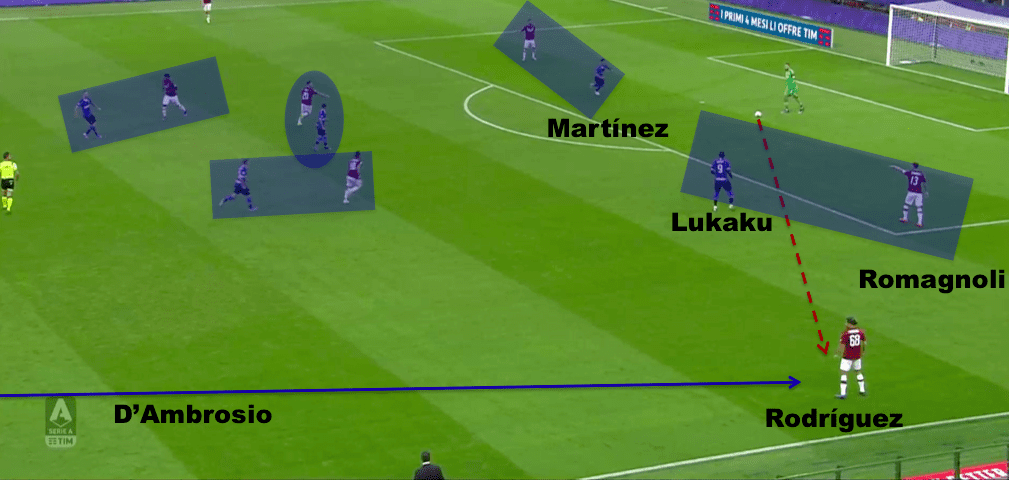
As seen in the image, Inter man-mark all of AC Milan’s outfield players excluding the full-backs. Martínez blocks the pass to Musacchio, while Lukaku forces the ball to the left side. Once Rodríguez receives the ball, D’Ambrosio (who is out of the picture due to his defensive responsibilities) rushes to press the Switzerland international.
Although AC Milan kept 52% possession, they were usually reduced to sideways passing and didn’t create many chances. Once they progressed the ball more, AC Milan employed a lopsided front three. Leão went wide on the left in an attempt to isolate Godin, while Suso and Piątek remained relatively central. The average position map below for AC Milan shows this shape. Leão (#17) is wide on the left, while Suso (#8) stays close to Piątek (#9).
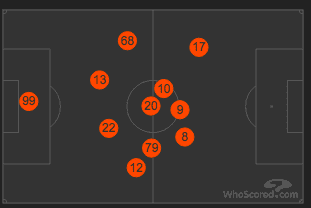
Inter’s wide diamond build-up
When playing out from the back, Inter kept a wide diamond shape. Godin went wide into a right-back position, while Škriniar did the same on the left. De Vrij stayed central while Brozović dropped just in front of the back three in support. Inter had no difficulty playing out as AC Milan’s defensive structure was a 4-3-3, which played right into Inter’s hands. Wingers Leão and Suso came narrow alongside Piątek when out of possession, and this created a very narrow front three which Inter’s wide diamond easily bypassed. On top of this, Brozović’s supporting drop towards his back three was uncontested as AC Milan’s midfield three did not push up to aid their front line, leaving Brozović in space. AC Milan’s narrow structure left Škriniar and Godin unopposed to receive the ball out wide.
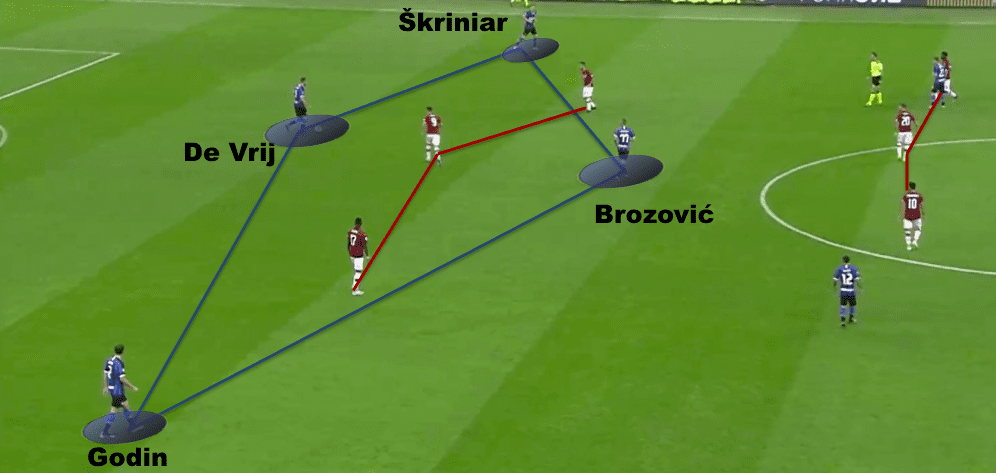
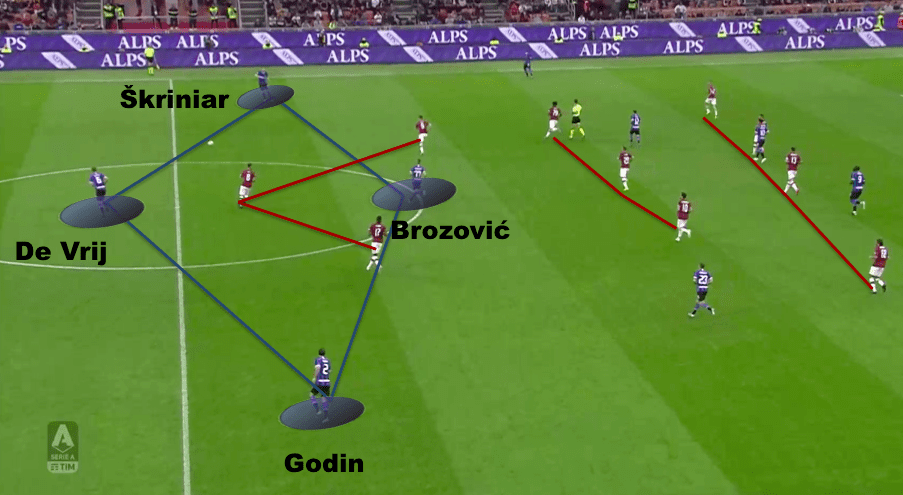
AC Milan’s pressing schemes
When the ball was played wide, the entirety of AC Milan’s defensive structure shifted to that side. The exception to this was Piątek and the ball far winger. Piątek stayed centrally, while the ball far winger only slightly changed his position to come near Piątek, but still stayed relatively wide. The winger on the ball’s side would force the ball to the touchline, where AC Milan’s full-back and central midfielder from that side would compress that space, forcing a turnover or Inter to look elsewhere.
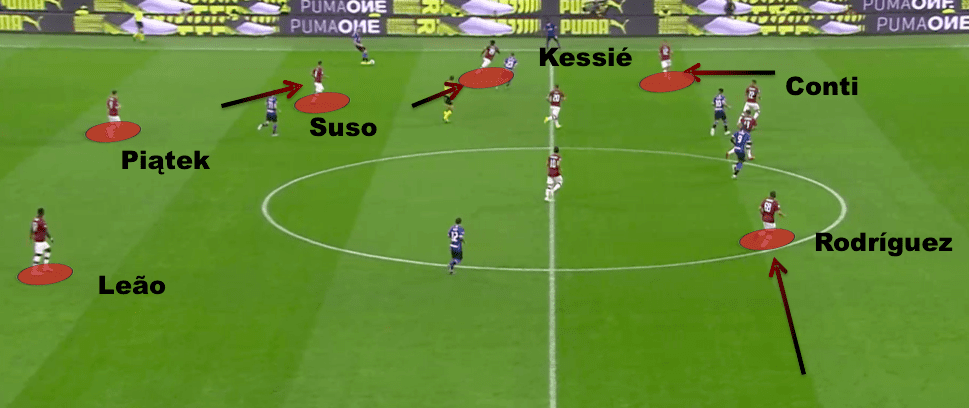
As seen in the image, Suso forces the Inter play wide, while Conti and Kessié press. Left-back Rodríguez tucks in alongside the rest of the defensive line to compensate for Conti’s pressing movement.
Politano’s introduction stretches AC Milan’s backline
Inter’s second goal, scored by Lukaku, shows exactly why this performance from Inter was an Antonio Conte masterclass. In the 76th minute, Matteo Politano replaced Martínez as Inter switched to a lopsided 3-5-2 with Politano as a right-winger. Politano looked to stretch AC Milan’s backline, as Inter kept Lukaku central, pinning the centre backs while Inter created a 2v1 on the left-wing.
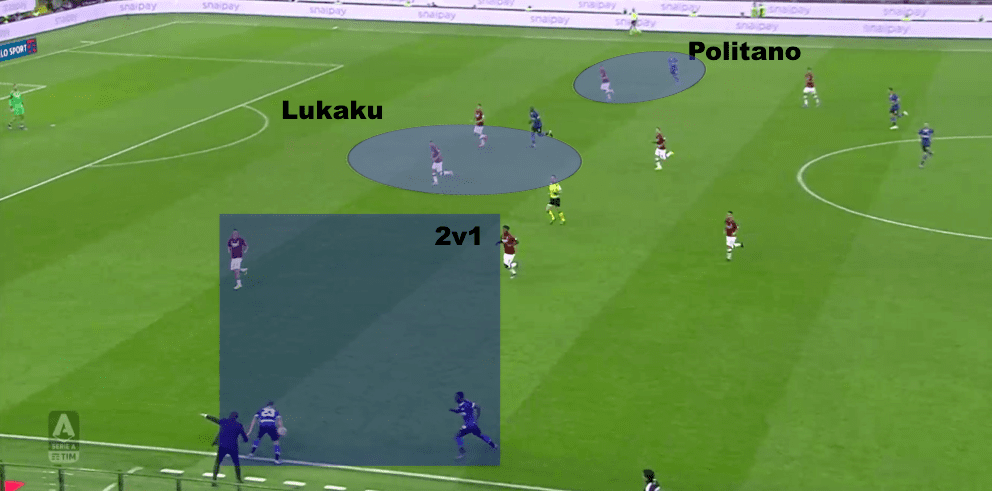
As seen in the above image, Lukaku is pinning Romagnoli and Musacchio, keeping them central. Politano is pinning AC Milan’s left-back. This isolates Conti at right-back so Barella and Asamoah create a 2v1 situation on the left wing.
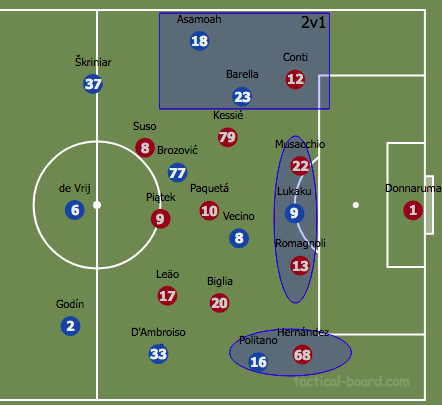
In the above diagram, we can see how Politano’s introduction to the game completely stretched AC Milan’s defensive line, and a textbook execution of this gameplan led to Inter’s second goal, putting the final nail in the Rossoneri’s coffin.
Conclusion
Inter faced the toughest test so far this season and comfortably beat city rivals AC Milan 2-0. Conte’s men maintained their perfect start to the league, the only Serie A team to do so, and this left them top of the table, with a two-point gap between them and second-placed Juventus, with Inter having a six better goal difference. This comfortable win will help Inter fans forget the disappointing 1-1 draw at home to Slavia Praha in the UEFA Champions League. However, failing to beat arguably the group’s worst team will not bode well as they are still to face Barcelona and Borussia Dortmund. Inter turn their attention to Simone Inzaghi’s Lazio next time out.
AC Milan continued their inconsistent start to the season, now sitting twelfth after four games, with two losses and two wins. Marco Giampaolo will not look forward to travelling to Torino, but will be encouraged by Torino’s recent 1-0 loss to Sampdoria.

If you love tactical analysis, then you’ll love the digital magazines from totalfootballanalysis.com – a guaranteed 100+ pages of pure tactical analysis covering topics from the Premier League, Serie A, La Liga, Bundesliga and many, many more. Buy your copy of the August issue for just ₤4.99 here





Comments